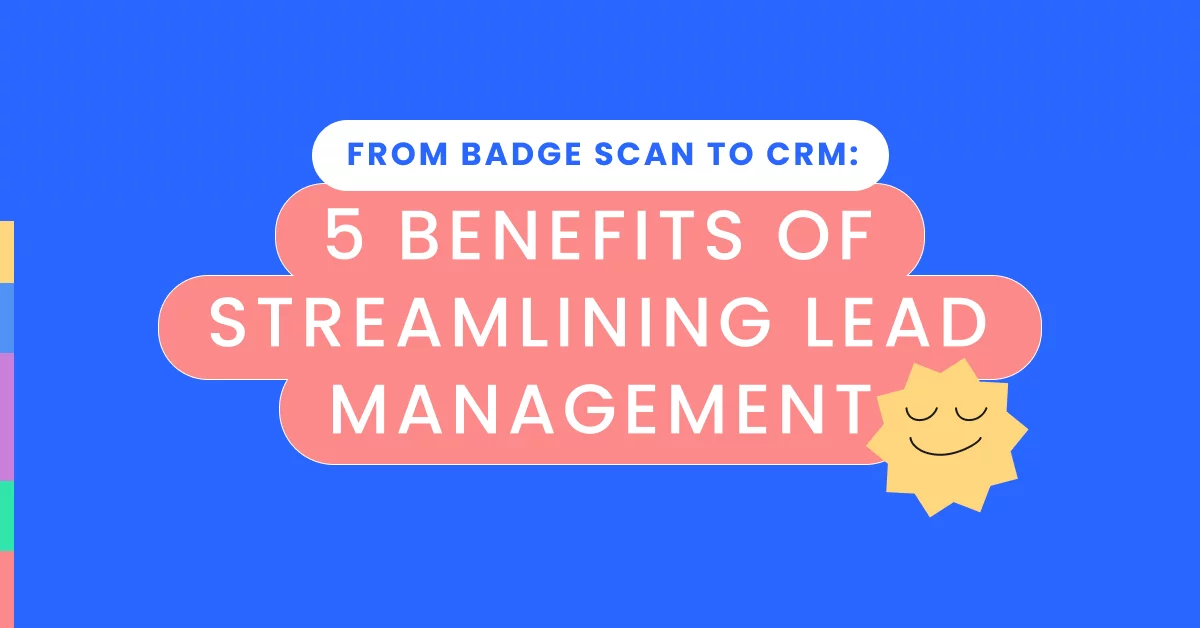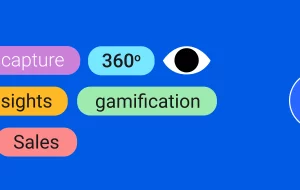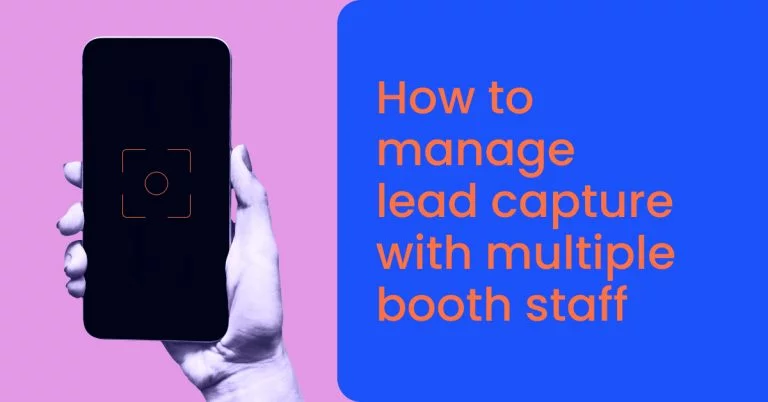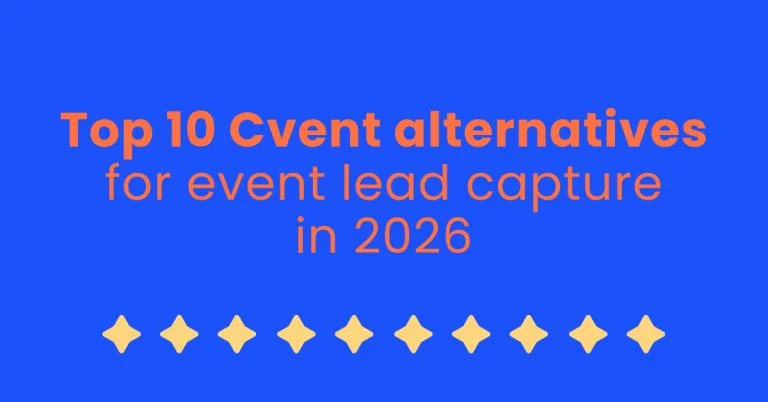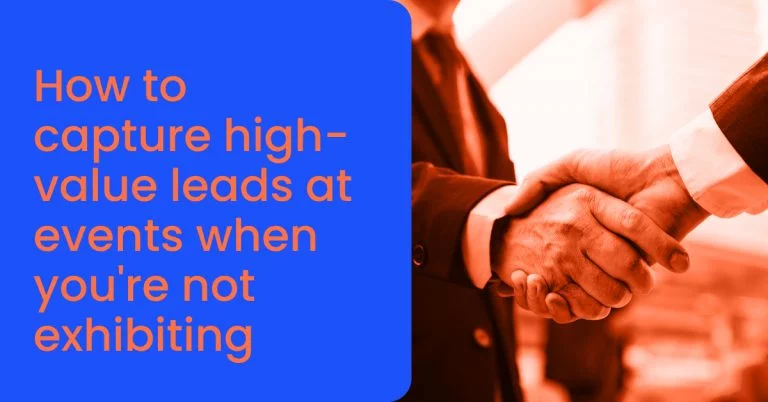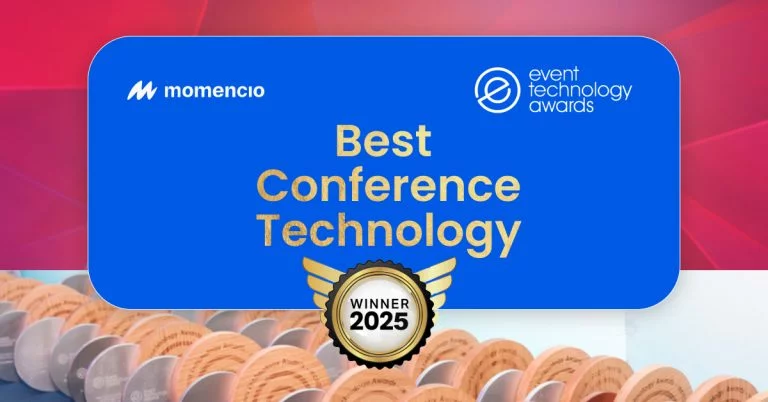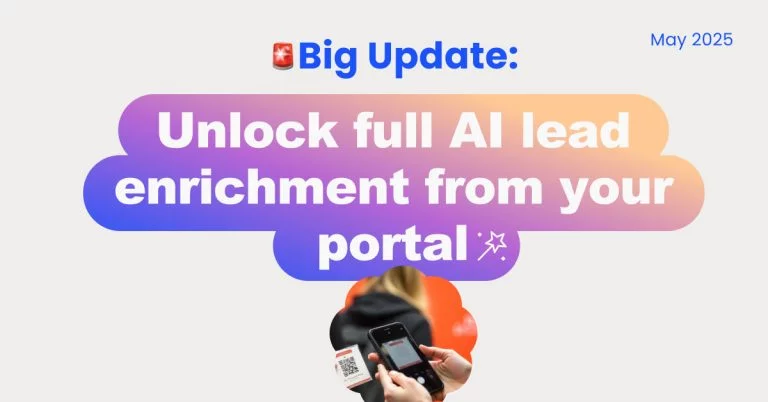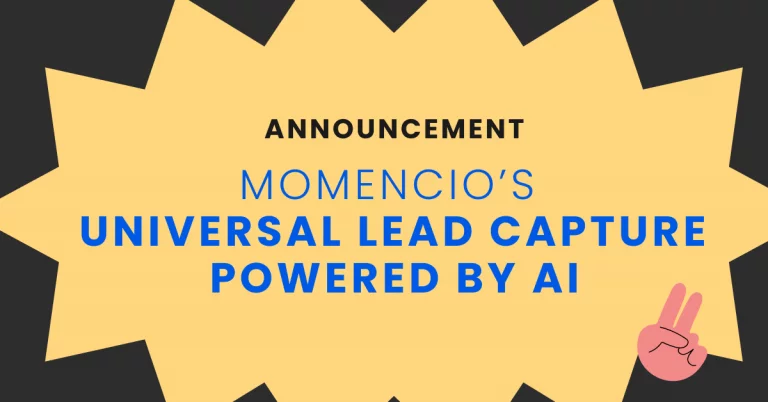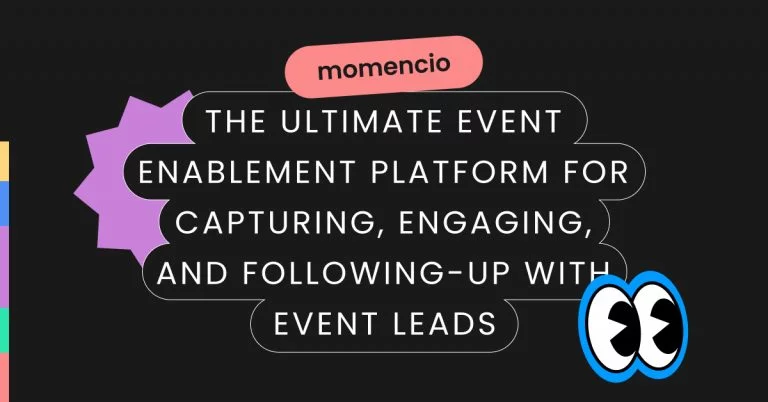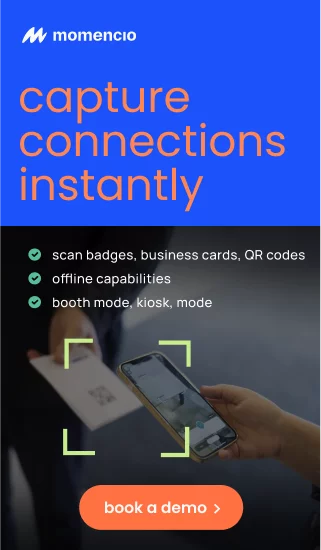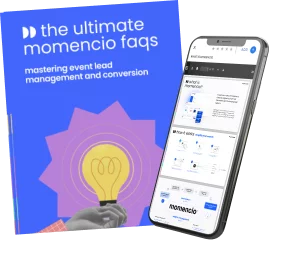Efficient lead management is crucial for event success, especially in a highly competitive market where every interaction counts. With events driving 20-25% of overall B2B leads, the need for streamlined lead capture and management processes has never been greater. Badge scanning technology has revolutionized how leads are captured at events, significantly increasing efficiency and data accuracy. According to EventMB, incorporating badge scanning at events can boost lead retrieval by up to 40% compared to manual methods.
Integrating event data with CRM systems further enhances lead management by ensuring seamless transition and timely follow-up, resulting in up to a 30% increase in conversion rates. Automated follow-up emails triggered by badge scans have a 35% higher open rate than standard marketing emails, highlighting the importance of timely and personalized communication in post-event engagement.
The Role of Badge Scanning in Lead Capture
Efficient lead capture is the cornerstone of successful event management. For event planners and field marketers, capturing leads seamlessly and accurately is not just a necessity but a strategic advantage. Traditional methods of lead capture, such as collecting business cards or manually noting down contact details, are time-consuming and prone to errors. This is where badge scanning technology comes into play, offering a modern solution that streamlines the process and enhances data accuracy.
Benefits of Badge Scanning Technology
- Speed and Efficiency: Badge scanning significantly reduces the time required to capture lead information. By simply scanning an attendee’s badge, all relevant details are instantly recorded. This allows event staff to focus more on engaging with attendees rather than getting bogged down with manual data entry. According to a report by EventTechHub, events that implement badge scanning experience a 50% reduction in lead capture time compared to manual methods.
- Data Accuracy: Manual data entry is susceptible to errors such as typos or illegible handwriting. Badge scanners eliminate these issues by capturing data directly from the source. This ensures that the information entered into your CRM or lead management system is accurate and complete, reducing the need for follow-up corrections and enhancing the quality of your leads.
- Real-Time Data Integration: Badge scanning technology often integrates with CRM systems in real-time, allowing for immediate data transfer. This means that as soon as a badge is scanned, the lead’s information is available to your sales and marketing teams. Real-time data integration enables quick follow-ups and personalized communication, which can significantly improve conversion rates.
- Enhanced Attendee Experience: For attendees, badge scanning offers a seamless and non-intrusive way to share their information. It reduces the hassle of filling out forms or exchanging business cards, making their experience more pleasant and professional. This positive interaction can enhance their perception of your brand and increase their willingness to engage further.
Comparing Manual Lead Retrieval Methods to Badge Scanning
Manual Lead Retrieval:
- Time-Consuming: Requires significant time for data entry during and after the event.
- Error-Prone: High likelihood of errors in data collection and entry.
- Inconsistent Follow-Up: Delays in data processing can lead to consistent and timely follow-ups.
- Labor-Intensive: Demands more staff and resources to manage lead capture.
Badge Scanning:
- Efficient: Captures lead information instantly with minimal effort.
- Accurate: Reduces errors associated with manual data entry.
- Real-Time: Provides immediate access to lead data for quick follow-up.
- Resource-Friendly: Requires fewer staff to manage the lead capture process.
Implementing Badge Scanning Technology
- Choosing the Right System: Selecting the appropriate badge scanning system is crucial. Consider factors such as integration capabilities with your existing CRM, ease of use, and the ability to capture and enrich data in real-time. Look for solutions that offer robust support and training to ensure a smooth implementation.
- Training Your Team: Proper training is essential to maximize the benefits of badge scanning technology. Ensure that your event staff are well-versed in using the scanners and understand the importance of capturing accurate data. Conduct training sessions before the event to address any potential issues and familiarize the team with the new process.
- Promoting the Technology to Attendees: Communicate the use of badge scanning to your attendees before the event. Highlight the benefits, such as quicker check-ins and less hassle in sharing information. This prepares attendees for the technology and reduces any resistance to its use.
- Monitoring and Optimizing: During the event, monitor the badge scanning process to identify any bottlenecks or issues. Gather feedback from your team and attendees to make any necessary adjustments. After the event, review the captured data and the overall process to identify areas for improvement in future events.
Integrating Event Data with CRM Systems
Integrating event data with Customer Relationship Management (CRM) systems is a game-changer for event planners and field marketers. This integration ensures that the valuable information collected during events is seamlessly transferred into a centralized system, enabling effective lead management and personalized follow-up strategies. By leveraging CRM integration, businesses can maximize the potential of their event leads and enhance their overall event ROI.
Benefits of CRM Integration for Lead Management
- Centralized Data Management: Integrating event data with a CRM system allows for centralized data management. All lead information collected through badge scans and other methods is automatically stored in the CRM, providing a single source of truth. This centralization simplifies data access and ensures that all team members have up-to-date information at their fingertips.
- Enhanced Lead Tracking: A CRM system enables comprehensive lead tracking. It provides detailed insights into each lead’s journey, from the initial point of contact at the event to subsequent interactions and follow-ups. This visibility helps sales and marketing teams understand lead behavior, preferences, and engagement levels, allowing for more targeted and effective communication.
- Improved Follow-Up Efficiency: With CRM integration, follow-up actions can be automated and personalized based on the data collected. Automated workflows can trigger personalized emails, assign tasks to sales representatives, and schedule follow-up activities. This automation ensures timely and consistent communication, which is crucial for keeping leads warm and engaged.
- Data-Driven Insights: CRM systems offer powerful analytics and reporting capabilities. By analyzing event data, businesses can gain insights into lead quality, engagement metrics, and overall event performance. These insights enable data-driven decision-making, helping companies refine their event strategies and improve future outcomes.
- Streamlined Sales Processes: Integrating event data with CRM systems streamlines sales processes by providing a complete view of each lead. Sales teams can access detailed lead profiles, including interaction history, preferences, and notes from the event. This information empowers sales representatives to tailor their approach and engage leads more effectively, increasing the likelihood of conversion.
Steps for Seamless Data Transfer from Events to CRM
- Choose the Right CRM Platform: Selecting a CRM platform that supports seamless integration with event management tools is crucial. Look for platforms that offer robust integration capabilities, scalability, and user-friendly interfaces. Ensure that the chosen CRM can handle the volume of data and interactions generated by your events.
- Utilize Integration Tools: Leverage integration tools and APIs to connect your event management software with your CRM system. Many event management platforms offer pre-built integrations with popular CRM systems, simplifying the setup process. These tools facilitate the automatic transfer of lead data, eliminating the need for manual data entry.
- Define Data Fields and Mapping: Before integrating, define the data fields that need to be captured and mapped between the event management software and the CRM. Common data fields include contact information, company details, interaction history, and engagement scores. Ensuring proper data mapping ensures that information flows accurately and consistently between systems.
- Set Up Automation Workflows: Configure automation workflows within your CRM to streamline lead management. Automated workflows can trigger actions such as sending follow-up emails, assigning leads to sales representatives, and updating lead statuses. Customize these workflows based on your lead nurturing strategy to ensure timely and relevant follow-ups.
- Train Your Team: Provide comprehensive training to your team on using the integrated systems. Ensure that they understand how to capture and input data accurately during events and how to utilize the CRM for follow-up activities. Training helps maximize the benefits of CRM integration and ensures smooth adoption across the organization.
Check out momencio’s integration with Hubspot and more.
Implementing CRM Integration Best Practices
- Start with Clear Objectives: Define clear objectives for integrating event data with your CRM system. Identify the key metrics you want to track, the outcomes you aim to achieve, and the specific pain points you want to address. Having clear objectives will guide the integration process and ensure alignment with your business goals.
- Prioritize Data Quality: Ensure that the data captured during events is accurate and complete. Implement validation checks during the badge scanning process to minimize errors. Regularly clean and update your CRM database to maintain data quality and relevance.
- Monitor and Optimize: Continuously monitor the performance of your integrated systems and workflows. Gather feedback from your team and analyze the results to identify areas for improvement. Make necessary adjustments to optimize the integration and maximize its impact on lead management and conversion rates.
- Leverage Analytics: Utilize the analytics capabilities of your CRM system to gain insights into lead behavior and event performance. Analyze metrics such as lead source, engagement levels, and conversion rates to refine your event strategies. Use these insights to make data-driven decisions and improve future event outcomes.
- Foster Collaboration: Encourage collaboration between your event management, marketing, and sales teams. Ensure that all teams are aligned on the integration process and understand their roles in capturing, managing, and following up with leads. Effective collaboration enhances the overall efficiency and success of your lead management efforts.
Post-Event Follow-Up Strategies
Effective post-event follow-up is critical for converting leads captured during events into long-term clients. Timely and personalized communication helps maintain engagement, build relationships, and ultimately drive sales. In this section, we will explore the importance of timely follow-up, the tools and technologies that can automate and enhance this process, and the role of personalization in post-event communication.
Post-event Follow-up: 6 Ways to Maintain Momentum After Your Event
Importance of Timely Follow-Up
- Keeping Leads Warm: Leads captured at events are often highly engaged and interested in your products or services. However, this interest can wane quickly if not nurtured. According to a study by InsideSales.com, the likelihood of converting a lead decreases significantly as time passes. Following up within the first 24 to 48 hours after the event is crucial to keeping leads warm and engaged.
- Establishing Prompt Communication: Prompt follow-up demonstrates professionalism and attentiveness. It shows that your company values the lead’s interest and is committed to providing timely information and support. This positive first impression can set the tone for a successful business relationship.
- Enhancing Recall: The sooner you follow up with leads, the better they will remember their interaction with your team at the event. Immediate follow-up helps reinforce the connection made during the event, making it easier to continue the conversation and move the lead further down the sales funnel.
Strategies for Post-Event Data Utilization: Fueling Growth and Engagement
Tools and Technologies for Automated Follow-Up
- Email Automation: Email automation tools enable you to send personalized follow-up emails to leads immediately after the event. These tools can trigger emails based on specific actions, such as badge scans or interactions recorded during the event. Personalized emails have been shown to increase open rates by 29% and click-through rates by 41%, according to Experian.
- CRM Integration: Integrating your event data with a CRM system allows for automated follow-up workflows. CRM systems can segment leads based on various criteria, such as interest level, engagement during the event, and interaction history. Automated workflows can then send targeted follow-up emails, assign leads to sales representatives, and schedule follow-up calls.
- Marketing Automation Platforms: Marketing automation platforms like HubSpot, Marketo, and Pardot offer comprehensive tools for post-event follow-up. These platforms can automate a series of follow-up actions, including emails, social media outreach, and personalized content delivery. They also provide analytics to track the effectiveness of your follow-up campaigns.
- Personalized Microsites: Creating personalized microsites for leads can enhance the follow-up experience. These microsites can include tailored content, such as product information, case studies, and demo videos, based on the lead’s interests and interactions during the event. Personalized content helps keep leads engaged and provides valuable information that can aid their decision-making process.
Personalization in Post-Event Communication
- Customizing Content: Personalization goes beyond addressing leads by their names. It involves tailoring the content and messaging to match the lead’s specific needs and interests. For example, suppose a lead showed interest in a particular product or service during the event. In that case, the follow-up email should provide detailed information about that offering, including benefits, features, and case studies.
- Segmenting Leads: Segmenting leads based on their interactions and behavior during the event allows for more targeted follow-up. For instance, leads who attended a product demo can receive follow-up emails with additional resources about the product. In contrast, those who participated in a networking session can receive information about upcoming events and networking opportunities.
- Utilizing Behavioral Data: Behavioral data collected during the event, such as booth visits, session attendance, and survey responses, can provide valuable insights for personalization. This data can be used to create tailored follow-up campaigns that address the lead’s specific interests and pain points, increasing the likelihood of conversion.
- Offering Value: Personalized follow-up should always aim to provide value to the lead. This can be in the form of educational content, exclusive offers, or invitations to webinars and events. Providing valuable information helps build trust and positions your company as a thought leader in the industry.
Steps to Implement Effective Post-Event Follow-Up
- Plan Ahead: Develop a follow-up strategy before the event. Identify the types of content and communication channels that will be used for follow-up, and create templates for emails and other outreach materials. This preparation ensures that you can execute your follow-up plan promptly after the event.
- Segment Your Leads: Use the data collected during the event to segment your leads based on their interests, engagement levels, and potential value. This segmentation allows for more targeted and relevant follow-up communication.
- Personalize Your Communication: Craft personalized messages that address the lead’s specific interests and needs. Use the information gathered during the event to tailor your content and make your communication more relevant and engaging.
- Automate Where Possible: Leverage automation tools to streamline the follow-up process. Set up automated workflows that trigger personalized emails and other follow-up actions based on the lead’s interactions and behavior during the event.
- Monitor and Adjust: Track the performance of your follow-up campaigns using analytics tools. Monitor metrics such as open rates, click-through rates, and conversion rates to assess the effectiveness of your follow-up strategy. Use this data to make adjustments and optimize your campaigns for better results.
Check out our guide: Maximizing post-event engagement
Optimizing Event ROI with Advanced Analytics
Leveraging advanced analytics to optimize event ROI is crucial for event planners and field marketers aiming to maximize the impact of their events. By harnessing data-driven insights, businesses can make informed decisions, improve event strategies, and ultimately enhance lead management and conversion rates.
The Role of Data Analytics in Event Planning and Lead Management
- Understanding Attendee Behavior: Data analytics provides valuable insights into attendee behavior, such as which sessions they attended, how much time they spent at each booth, and which activities they engaged with the most. This information helps event planners understand what interests their audience and tailor future events accordingly.
- Measuring Engagement: Analytics tools can measure attendee engagement in real time, tracking metrics such as session attendance, booth interactions, and participation in surveys or polls. High engagement levels often correlate with higher lead quality, making it easier to prioritize follow-up efforts.
- Assessing Lead Quality: Advanced analytics can help assess the quality of leads captured during events by analyzing their interactions and engagement levels. By identifying high-quality leads, sales teams can focus their efforts on those with the highest potential for conversion, improving efficiency and outcomes.
- Identifying Trends and Patterns: Analyzing data from multiple events can reveal trends and patterns in attendee behavior and preferences. These insights can inform event planning strategies, such as which topics to cover in future sessions, optimal booth placements, and the best times to schedule key activities.
- Enhancing Personalization: Data analytics enables more personalized communication with leads by providing detailed insights into their interests and behaviors. Personalized follow-ups are more likely to resonate with leads, increasing engagement and conversion rates.
10 proven strategies for boosting event ROI and engagement
Real-time event Insights for Better Decision-Making
- Real-Time Dashboard: Implementing a real-time dashboard during events allows event planners to monitor critical metrics as they happen. This includes tracking attendee registrations, session attendance, booth traffic, and engagement levels. Real-time insights enable quick adjustments to enhance the event experience and optimize lead capture.
- Heat Maps: Heat maps visually represent attendee movement and engagement within the event venue. They highlight high-traffic areas and popular booths, helping planners optimize space utilization and improve the layout for future events. Understanding where attendees spend the most time can also inform targeted follow-up strategies.
- Session Analytics: Analyzing session data provides insights into which topics and speakers attracted the most attendees. This information is valuable for planning future events, selecting speakers, and choosing relevant session topics. Additionally, understanding which sessions were most engaging can guide content creation for follow-up communications.
- Social Media Analytics: Monitoring social media activity during events can reveal attendee sentiments, popular topics, and overall event buzz. Social media analytics help gauge the event’s impact and reach, providing additional data points for optimizing future events and enhancing engagement strategies.
Measuring and Improving Event Performance
- Key Performance Indicators (KPIs): Identifying and tracking key performance indicators (KPIs) is essential for measuring event success. Common KPIs include lead volume, lead quality, attendee satisfaction, session attendance, and social media engagement. Establishing clear KPIs helps measure the effectiveness of event strategies and identify areas for improvement.
- Post-Event Surveys: Conducting post-event surveys is a valuable way to gather feedback from attendees. Surveys can capture insights into various aspects of the event, such as content quality, speaker effectiveness, logistics, and overall satisfaction. Analyzing survey results helps identify strengths and weaknesses, guiding improvements for future events.
- Conversion Tracking: Tracking lead conversions from initial capture to final sale provides a comprehensive view of event ROI. By analyzing conversion rates and sales outcomes, businesses can assess the effectiveness of their lead management and follow-up strategies. Understanding which tactics yield the highest conversions informs future event planning.
- Cost-Benefit Analysis: Conducting a cost-benefit analysis helps determine the overall ROI of the event. This involves comparing the total costs of organizing the event (venue, marketing, staffing, etc.) against the revenue generated from lead conversions and sales. A positive ROI indicates a successful event, while areas with negative ROI highlight opportunities for cost optimization.
- Continuous Improvement: Using the insights gained from data analytics, businesses can implement a cycle of continuous improvement. Regularly reviewing event performance data and making iterative changes to strategies ensures that each event is better than the last. This proactive approach enhances lead management, increases engagement, and boosts overall event ROI.
Tools and Technologies for Event Analytics
- Event Management Software: Event management platforms like Cvent, Eventbrite, and Bizzabo offer comprehensive analytics tools that track various event metrics. These platforms provide dashboards, heat maps, and detailed reports that help planners monitor and analyze event performance in real-time.
- CRM Systems: CRM systems such as Salesforce, HubSpot, and Zoho CRM integrate with event management tools to provide a unified view of lead data. CRM analytics can track lead interactions, engagement levels, and conversion rates, offering valuable insights for optimizing lead management.
- Marketing Automation Platforms: Marketing automation platforms like Marketo, Pardot, and HubSpot offer advanced analytics capabilities. These platforms track lead behavior, measure campaign performance, and provide insights into the effectiveness of follow-up strategies. Integrating event data with marketing automation platforms enhances personalization and engagement.
- Survey Tools: Survey tools like SurveyMonkey, Typeform, and Qualtrics enable event planners to create and distribute post-event surveys. These tools offer analytics features that help analyze survey responses and gather actionable insights for improving future events.
- Social Media Monitoring Tools: Social media monitoring tools like Hootsuite, Sprout Social, and Brandwatch track social media activity and engagement during events. These tools provide real-time insights into attendee sentiments and event reach, helping planners gauge the event’s impact and optimize social media strategies.
Read more about The power of lead scoring in managing multi-channel event marketing efforts
Enhancing Sales Enablement through Lead Management
Effective lead management is a cornerstone of successful sales enablement. By capturing, nurturing, and converting leads efficiently, businesses can ensure that their sales teams are equipped with high-quality prospects that are primed for conversion. This section explores how integrating lead capture with sales processes, employing strategies for nurturing leads, and implementing effective lead management practices can enhance sales enablement and drive business growth.
Integrating Lead Capture with Sales Processes
- Seamless Data Flow: Integrating lead capture processes with sales workflows ensures that captured leads are promptly and accurately transferred to the sales team. By using tools like CRM systems and marketing automation platforms, businesses can streamline the data flow, reducing manual data entry and the risk of errors. This seamless integration allows sales teams to access complete lead profiles, including contact details, interaction history, and engagement levels, enabling them to tailor their approach effectively.
- Real-Time Lead Scoring: Implementing real-time lead scoring systems helps prioritize leads based on their engagement levels and potential value. By assigning scores to leads based on factors such as event interactions, content engagement, and demographic information, sales teams can focus their efforts on high-priority leads. This targeted approach increases the efficiency of the sales process and enhances the likelihood of conversion.
- Automated Lead Assignment: Automated lead assignment ensures that leads are quickly distributed to the appropriate sales representatives based on predefined criteria. This could include factors such as geographic location, industry, or lead score. Automated assignment reduces response times and ensures that leads are promptly followed up by the most suitable team members, improving the chances of conversion.
Strategies for Nurturing Leads Toward Conversion
- Personalized Follow-Up: Personalization is essential to effective lead nurturing. Using the data collected during events, businesses can craft personalized follow-up messages that address the specific interests and needs of each lead. Customized emails, tailored content, and targeted offers resonate more with leads, increasing engagement and driving them further down the sales funnel.
- Multi-Channel Communication: Employing a multi-channel communication strategy ensures that leads are engaged across various touchpoints. This includes email, social media, phone calls, and direct mail. By reaching leads through their preferred channels, businesses can maintain consistent communication and build stronger relationships. Multi-channel engagement also increases the chances of reaching leads at the right time, improving conversion rates.
- Drip Campaigns: Drip campaigns involve sending a series of pre-written emails to leads over a specified period. These campaigns can be tailored to the lead’s stage in the sales funnel and their interactions with previous communications. Drip campaigns keep leads engaged by providing valuable information, addressing pain points, and gradually guiding them toward a purchase decision.
- Content Marketing: Providing valuable content is an effective way to nurture leads. This can include blog posts, whitepapers, case studies, webinars, and videos that address the lead’s challenges and offer solutions. High-quality content positions the business as a thought leader and builds trust with leads, making them more likely to consider the company’s products or services.
Read more about the Top 10 Methods to Convert Event Leads to Clients
Impact of Effective Lead Management on Sales Enablement
- Increased Conversion Rates: Effective lead management practices ensure that leads are nurtured with relevant and timely communication, increasing the likelihood of conversion. By maintaining consistent engagement and providing valuable information, businesses can guide leads through the sales funnel more effectively, resulting in higher conversion rates.
- Shortened Sales Cycles: Efficient lead management and nurturing can significantly shorten sales cycles. By promptly following up with leads and addressing their needs, sales teams can accelerate the decision-making process. Automated workflows and real-time data insights further streamline the sales process, reducing the time it takes to convert leads into customers.
- Enhanced Sales Productivity: Integrating lead capture and management with sales processes improves sales team productivity. Automated lead scoring, assignment, and follow-up workflows reduce manual tasks, allowing sales representatives to focus on engaging with leads and closing deals. Access to comprehensive lead profiles also enables more informed and effective sales interactions.
- Improved Sales and Marketing Alignment: Effective lead management fosters better alignment between sales and marketing teams. By sharing data and insights, both teams can collaborate more effectively on lead nurturing strategies. Marketing can provide sales with high-quality leads and valuable content, while sales can offer feedback on lead quality and campaign effectiveness. This alignment enhances overall lead management and improves business outcomes.
- Data-driven decision-making: Leveraging data analytics in lead management provides valuable insights into lead behavior, engagement levels, and conversion metrics. These insights enable businesses to make data-driven decisions, optimize lead nurturing strategies, and continuously improve their sales processes. Data-driven decision-making enhances the effectiveness of sales enablement efforts and drives better results.
Implementing Effective Lead Management Practices
- Define Clear Processes: Establish clear lead management processes that outline the steps for capturing, scoring, nurturing, and converting leads. Document these processes and ensure that all team members are trained on their roles and responsibilities. Clear processes ensure consistency and efficiency in lead management.
- Utilize Automation Tools: Leverage automation tools to streamline lead management tasks. CRM systems, marketing automation platforms, and lead scoring tools can automate data entry, lead assignment, follow-up workflows, and reporting. Automation reduces manual effort and ensures timely and accurate lead management.
- Monitor and Optimize: Regularly monitor lead management performance using analytics and reporting tools. Track key metrics such as lead volume, engagement levels, conversion rates, and sales cycle length. Use these insights to identify areas for improvement and optimize lead management strategies for better results.
- Foster Collaboration: Encourage collaboration between sales and marketing teams to ensure alignment on lead management goals and strategies. Regular meetings and communication channels can facilitate the sharing of insights, feedback, and best practices. Collaboration enhances the overall effectiveness of lead management efforts.
- Continuous Improvement: Adopt a mindset of continuous improvement in lead management. Regularly review and refine lead capture, nurturing, and conversion strategies based on data insights and feedback. Implementing incremental changes and improvements ensures that lead management practices remain effective and aligned with business goals.
If you want to know more about momencio and what it does, we answer all the important questions in a free ebook. Download it here
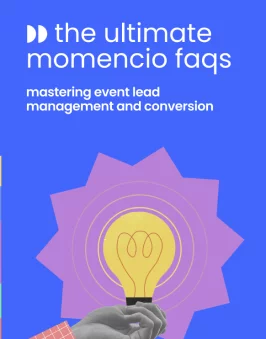
Conclusion
Efficient lead management is the linchpin of successful event marketing and sales enablement. From the initial capture of leads through badge scanning to the seamless integration with CRM systems and effective post-event follow-up strategies, each step plays a crucial role in converting leads into long-term clients. By leveraging advanced analytics and data-driven insights, businesses can optimize their event ROI, enhance sales productivity, and foster stronger alignment between marketing and sales teams.
Implementing best practices in lead management ensures that no lead is left behind and that every interaction is maximized for its potential to drive business growth. The integration of modern technologies like badge scanning and CRM systems, combined with personalized follow-up and targeted content, creates a robust framework for nurturing leads and achieving higher conversion rates.
In summary, the key takeaways for streamlining lead management include:
- Utilizing Badge Scanning Technology:
- Enhances speed and accuracy in lead capture.
- Provides real-time data integration for immediate follow-up.
- Improves the attendee experience with seamless information sharing.
- Integrating with CRM Systems:
- Centralizes data management and enhances lead tracking.
- Automates follow-up workflows for timely and consistent communication.
- Offers data-driven insights for informed decision-making.
- Effective Post-Event Follow-Up:
- Keeps leads engaged with timely and personalized communication.
- Employs automation tools to streamline the follow-up process.
- Utilizes multi-channel strategies to reach leads through preferred platforms.
- Optimizing Event ROI with Advanced Analytics:
- Provides real-time insights into attendee behavior and engagement.
- Measures and improves event performance through key metrics.
- Enables continuous improvement through data analysis and feedback.
- Enhancing Sales Enablement:
- Integrates lead capture with sales processes for seamless transitions.
- Employs strategies for nurturing leads toward conversion.
- Improves sales productivity and shortens sales cycles.
By adopting these strategies and leveraging the right tools, businesses can transform their event marketing efforts into powerful drivers of sales success.
Ready to revolutionize your event lead management? Book a demo with momencio today and discover how our comprehensive platform can transform your event interactions into valuable business relationships. With momencio, you can capture leads efficiently, integrate seamlessly with your CRM, and follow up effectively to maximize your event ROI.
FAQs – Badge Scan to CRM
- What is the advantage of using badge scanning technology at events? Badge scanning technology significantly enhances the efficiency and accuracy of lead capture. It reduces the time required for data entry, minimizes errors, and provides real-time integration with CRM systems, allowing for immediate follow-up and improved lead management.
- How does integrating event data with a CRM system improve lead management? Integrating event data with a CRM system centralizes lead information, making it easily accessible for sales and marketing teams. This integration enables automated workflows, real-time lead tracking, and personalized follow-up, enhancing the overall efficiency and effectiveness of lead management.
- What are some effective strategies for post-event follow-up? Effective post-event follow-up strategies include timely and personalized communication, using automation tools to streamline follow-up processes, employing multi-channel communication to reach leads through their preferred platforms, and providing valuable content to nurture leads toward conversion.
- How can data analytics optimize event ROI? Data analytics provides insights into attendee behavior, engagement levels, and event performance metrics. By analyzing this data, businesses can identify trends, measure success, and make data-driven decisions to optimize event strategies and improve ROI.
- What role does lead management play in sales enablement? Lead management plays a crucial role in sales enablement by ensuring that high-quality leads are efficiently captured, nurtured, and converted. Effective lead management practices shorten sales cycles, increase conversion rates, and improve sales productivity, driving overall business growth.
Interesting Facts from Research
- Lead Conversion Rates:
- Businesses that follow up with leads within 24 hours are nearly 60% more likely to qualify the lead compared to those who wait 48 hours or longer.
- Badge Scanning Efficiency:
- Events that utilize badge scanning technology see a 40% increase in lead retrieval efficiency compared to manual methods.
- CRM Integration Benefits:
- Companies that integrate their event data with CRM systems experience a 30% increase in conversion rates due to more effective lead management and follow-up strategies.
- Automated Follow-Up:
- Automated follow-up emails triggered by event interactions have a 35% higher open rate and a 21% higher click-through rate compared to standard marketing emails.
- Impact of Personalized Communication:
- Personalized emails generate six times higher transaction rates than non-personalized emails, emphasizing the importance of tailored communication in lead nurturing.
